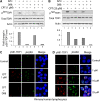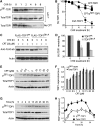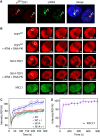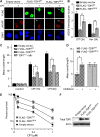Optimal function of the DNA repair enzyme TDP1 requires its phosphorylation by ATM and/or DNA-PK
- PMID: 19851285
- PMCID: PMC2790489
- DOI: 10.1038/emboj.2009.302
Optimal function of the DNA repair enzyme TDP1 requires its phosphorylation by ATM and/or DNA-PK
Abstract
Human tyrosyl-DNA phosphodiesterase (TDP1) hydrolyzes the phosphodiester bond at a DNA 3' end linked to a tyrosyl moiety. This type of linkage is found at stalled topoisomerase I (Top1)-DNA covalent complexes, and TDP1 has been implicated in the repair of such complexes. Here we show that Top1-associated DNA double-stranded breaks (DSBs) induce the phosphorylation of TDP1 at S81. This phosphorylation is mediated by the protein kinases: ataxia-telangiectasia-mutated (ATM) and DNA-dependent protein kinase (DNA-PK). Phosphorylated TDP1 forms nuclear foci that co-localize with those of phosphorylated histone H2AX (gammaH2AX). Both Top1-induced replication- and transcription-mediated DNA damages induce TDP1 phosphorylation. Furthermore, we show that S81 phosphorylation stabilizes TDP1, induces the formation of XRCC1 (X-ray cross-complementing group 1)-TDP1 complexes and enhances the mobilization of TDP1 to DNA damage sites. Finally, we provide evidence that TDP1-S81 phosphorylation promotes cell survival and DNA repair in response to CPT-induced DSBs. Together; our findings provide a new mechanism for TDP1 post-translational regulation by ATM and DNA-PK.
Conflict of interest statement
The authors declare that they have no conflict of interest.
Figures









Similar articles
-
TDP1 is required for efficient non-homologous end joining in human cells.DNA Repair (Amst). 2017 Dec;60:40-49. doi: 10.1016/j.dnarep.2017.10.003. Epub 2017 Oct 16. DNA Repair (Amst). 2017. PMID: 29078113
-
DNA-PK triggers histone ubiquitination and signaling in response to DNA double-strand breaks produced during the repair of transcription-blocking topoisomerase I lesions.Nucleic Acids Res. 2016 Feb 18;44(3):1161-78. doi: 10.1093/nar/gkv1196. Epub 2015 Nov 17. Nucleic Acids Res. 2016. PMID: 26578593 Free PMC article.
-
Association of XRCC1 and tyrosyl DNA phosphodiesterase (Tdp1) for the repair of topoisomerase I-mediated DNA lesions.DNA Repair (Amst). 2003 Oct 7;2(10):1087-100. doi: 10.1016/s1568-7864(03)00116-2. DNA Repair (Amst). 2003. PMID: 13679147
-
The ATM-dependent DNA damage signaling pathway.Cold Spring Harb Symp Quant Biol. 2005;70:99-109. doi: 10.1101/sqb.2005.70.002. Cold Spring Harb Symp Quant Biol. 2005. PMID: 16869743 Review.
-
The influence of heterochromatin on DNA double strand break repair: Getting the strong, silent type to relax.DNA Repair (Amst). 2010 Dec 10;9(12):1273-82. doi: 10.1016/j.dnarep.2010.09.013. Epub 2010 Oct 30. DNA Repair (Amst). 2010. PMID: 21036673 Review.
Cited by
-
ATM Protein Kinase: Old and New Implications in Neuronal Pathways and Brain Circuitry.Cells. 2020 Aug 26;9(9):1969. doi: 10.3390/cells9091969. Cells. 2020. PMID: 32858941 Free PMC article. Review.
-
Resolution of complex ends by Nonhomologous end joining - better to be lucky than good?Genome Integr. 2012 Dec 31;3(1):10. doi: 10.1186/2041-9414-3-10. Genome Integr. 2012. PMID: 23276302 Free PMC article.
-
ERK3 regulates TDP2-mediated DNA damage response and chemoresistance in lung cancer cells.Oncotarget. 2016 Feb 9;7(6):6665-75. doi: 10.18632/oncotarget.6682. Oncotarget. 2016. PMID: 26701725 Free PMC article.
-
ATM-mediated phosphorylation of polynucleotide kinase/phosphatase is required for effective DNA double-strand break repair.EMBO Rep. 2011 Jul 1;12(7):713-9. doi: 10.1038/embor.2011.96. EMBO Rep. 2011. PMID: 21637298 Free PMC article.
-
Analysis of the active-site mechanism of tyrosyl-DNA phosphodiesterase I: a member of the phospholipase D superfamily.J Mol Biol. 2012 Jan 27;415(4):741-58. doi: 10.1016/j.jmb.2011.11.044. Epub 2011 Dec 6. J Mol Biol. 2012. PMID: 22155078 Free PMC article.
References
-
- Abraham RT (2004) PI 3-kinase-related kinases: ‘big' players in stress-induced signaling pathways. DNA Repair (Amst) 3: 883–887 - PubMed
-
- Antony S, Marchand C, Stephen AG, Thibaut L, Agama KK, Fisher RJ, Pommier Y (2007) Novel high-throughput electrochemiluminescent assay for identification of human tyrosyl-DNA phosphodiesterase (Tdp1) inhibitors and characterization of furamidine (NSC 305831) as an inhibitor of Tdp1. Nucleic Acids Res 35: 4474–4484 - PMC - PubMed
-
- Audebert M, Salles B, Calsou P (2004) Involvement of poly(ADP-ribose) polymerase-1 and XRCC1/DNA ligase III in an alternative route for DNA double-strand breaks rejoining. J Biol Chem 279: 55117–55126 - PubMed
-
- Bakkenist CJ, Kastan MB (2003) DNA damage activates ATM through intermolecular autophosphorylation and dimer dissociation. Nature 421: 499–506 - PubMed
Publication types
MeSH terms
Substances
Grants and funding
LinkOut - more resources
Full Text Sources
Other Literature Sources
Molecular Biology Databases
Research Materials
Miscellaneous

